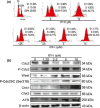HY-1 induces G(2)/M cell cycle arrest in human colon cancer cells through the ATR-Chk1-Cdc25C and Weel pathways
- PMID: 23600770
- PMCID: PMC7657130
- DOI: 10.1111/cas.12182
HY-1 induces G(2)/M cell cycle arrest in human colon cancer cells through the ATR-Chk1-Cdc25C and Weel pathways
Abstract
The novel aroylthiourea analogue of podophyllotoxin HY-1 (4β-[benzoyl-thioureido]-4-deoxypodophyllotoxin) was synthesized in our laboratory with the aim of developing multitargeted DNA topoisomerase II inhibitors. The compound showed significant antiproliferative effects on seven cancer cell lines and induced G2 /M phase arrest in HCT116 cells. Moreover, HY-1 showed a potent inhibitory effect on topoisomerase II-mediated kinetoplast DNA decatenation in a dose-dependent manner. Our results showed that cdc2 phosphorylation and decreased cdc2 kinase acitivity through the ATR-Chk1-Cdc25C and Weel pathways were the central mechanisms for G2 /M phase arrest in human colon cancer cells.
© 2013 Japanese Cancer Association.
Figures






Similar articles
-
Resveratrol analogue (E)-8-acetoxy-2-[2-(3,4-diacetoxyphenyl)ethenyl]-quinazoline induces G₂/M cell cycle arrest through the activation of ATM/ATR in human cervical carcinoma HeLa cells.Oncol Rep. 2015 May;33(5):2639-47. doi: 10.3892/or.2015.3871. Epub 2015 Mar 20. Oncol Rep. 2015. PMID: 25812484
-
Checkpoint kinase 1-mediated phosphorylation of Cdc25C and bad proteins are involved in antitumor effects of loratadine-induced G2/M phase cell-cycle arrest and apoptosis.Mol Carcinog. 2006 Jul;45(7):461-78. doi: 10.1002/mc.20165. Mol Carcinog. 2006. PMID: 16649252
-
Resveratrol causes Cdc2-tyr15 phosphorylation via ATM/ATR-Chk1/2-Cdc25C pathway as a central mechanism for S phase arrest in human ovarian carcinoma Ovcar-3 cells.Carcinogenesis. 2005 Nov;26(11):1978-87. doi: 10.1093/carcin/bgi165. Epub 2005 Jun 23. Carcinogenesis. 2005. PMID: 15975956
-
Jaridonin-induced G2/M phase arrest in human esophageal cancer cells is caused by reactive oxygen species-dependent Cdc2-tyr15 phosphorylation via ATM-Chk1/2-Cdc25C pathway.Toxicol Appl Pharmacol. 2015 Jan 15;282(2):227-36. doi: 10.1016/j.taap.2014.11.003. Epub 2014 Nov 20. Toxicol Appl Pharmacol. 2015. PMID: 25450480 Free PMC article.
-
Novel regulation of checkpoint kinase 1: Is checkpoint kinase 1 a good candidate for anti-cancer therapy?Cancer Sci. 2012 Jul;103(7):1195-200. doi: 10.1111/j.1349-7006.2012.02280.x. Epub 2012 Apr 23. Cancer Sci. 2012. PMID: 22435685 Free PMC article. Review.
Cited by
-
Longikaurin A, a natural ent-kaurane, induces G2/M phase arrest via downregulation of Skp2 and apoptosis induction through ROS/JNK/c-Jun pathway in hepatocellular carcinoma cells.Cell Death Dis. 2014 Mar 20;5(3):e1137. doi: 10.1038/cddis.2014.66. Cell Death Dis. 2014. PMID: 24651440 Free PMC article.
-
Mxi1-0 regulates the growth of human umbilical vein endothelial cells through extracellular signal-regulated kinase 1/2 (ERK1/2) and interleukin-8 (IL-8)-dependent pathways.PLoS One. 2017 Jun 2;12(6):e0178831. doi: 10.1371/journal.pone.0178831. eCollection 2017. PLoS One. 2017. PMID: 28575053 Free PMC article.
-
Caffeine and its main targets of colorectal cancer.World J Gastrointest Oncol. 2020 Feb 15;12(2):149-172. doi: 10.4251/wjgo.v12.i2.149. World J Gastrointest Oncol. 2020. PMID: 32104547 Free PMC article. Review.
-
G-quadruplex ligand-induced DNA damage response coupled with telomere dysfunction and replication stress in glioma stem cells.Biochem Biophys Res Commun. 2016 Feb 26;471(1):75-81. doi: 10.1016/j.bbrc.2016.01.176. Epub 2016 Feb 1. Biochem Biophys Res Commun. 2016. PMID: 26845351 Free PMC article.
-
The Topoisomerase 1 Inhibitor Austrobailignan-1 Isolated from Koelreuteria henryi Induces a G2/M-Phase Arrest and Cell Death Independently of p53 in Non-Small Cell Lung Cancer Cells.PLoS One. 2015 Jul 6;10(7):e0132052. doi: 10.1371/journal.pone.0132052. eCollection 2015. PLoS One. 2015. PMID: 26147394 Free PMC article.
References
-
- Schrecker AW, Hartwell JL. Communications‐components of podophyllin. XX. The absolute configuration of podophyllotoxin and related lignans. J Org Chem 1956; 21: 381–2.
-
- Hande KR. Etoposide: four decades of development of a topoisomerase II inhibitor. Eur J Cancer 1998; 34: 1514–21. - PubMed
-
- Zhao Y, Wang CN, Wu ZH, Fang JH, Zhu L. Synthesis and antitumor activity of novel aroylthiourea derivatives of podophyllotoxin. Invest New Drugs 2012; 30: 17–24. - PubMed
-
- Dai XJ, Yamasaki KS, Yang LJ et al Keratinocyte G2/M growth arrest by 1,25‐dihydroxyvitamin D3 Is caused by Cdc2 phosphorylation through Wee1 and Myt1 regulation. J Invest Dermatol 2004; 122: 1356–64. - PubMed
Publication types
MeSH terms
Substances
LinkOut - more resources
Full Text Sources
Other Literature Sources
Research Materials
Miscellaneous

